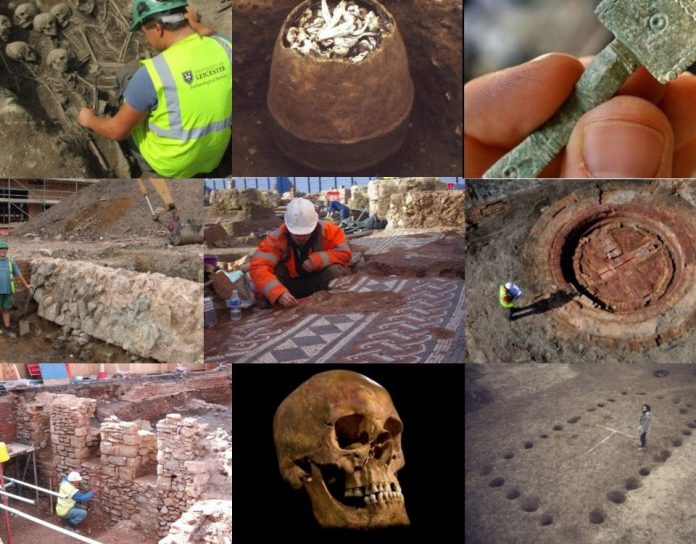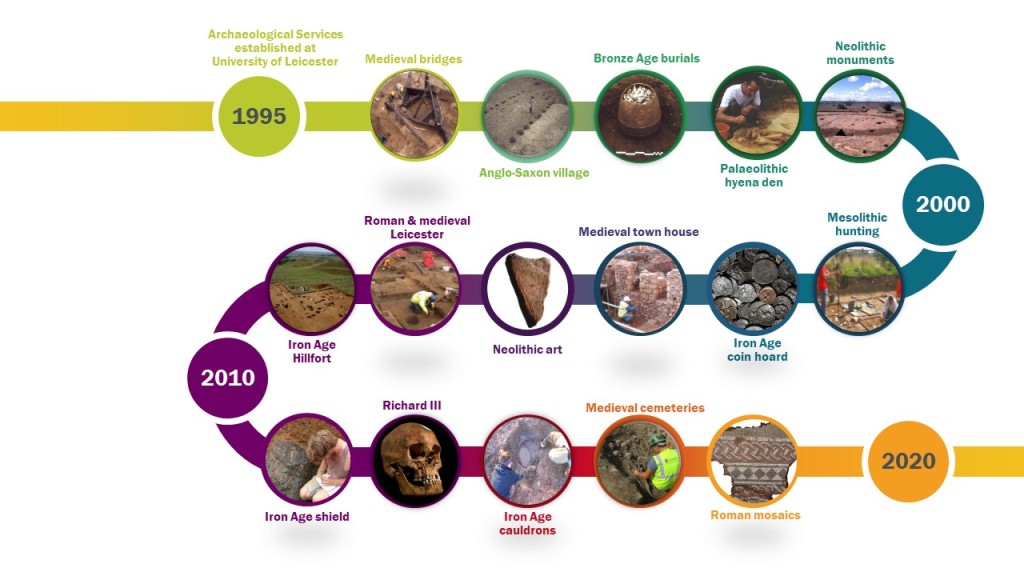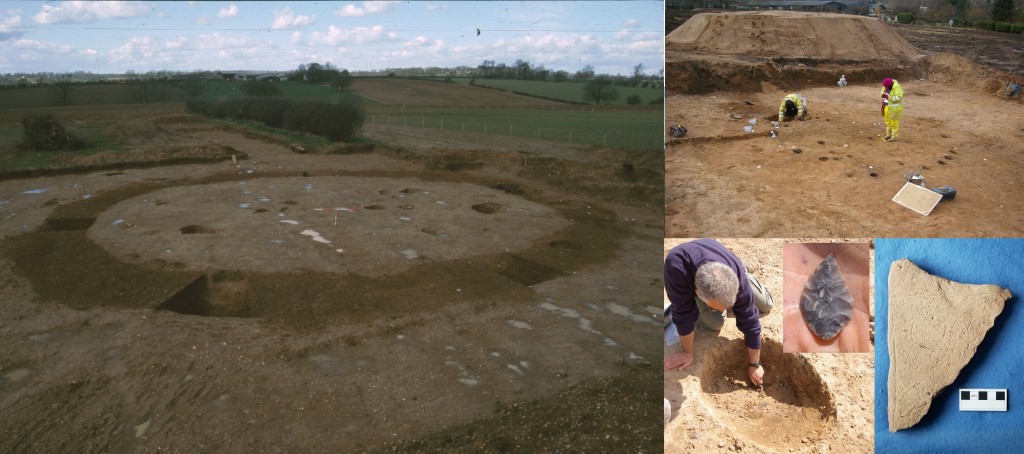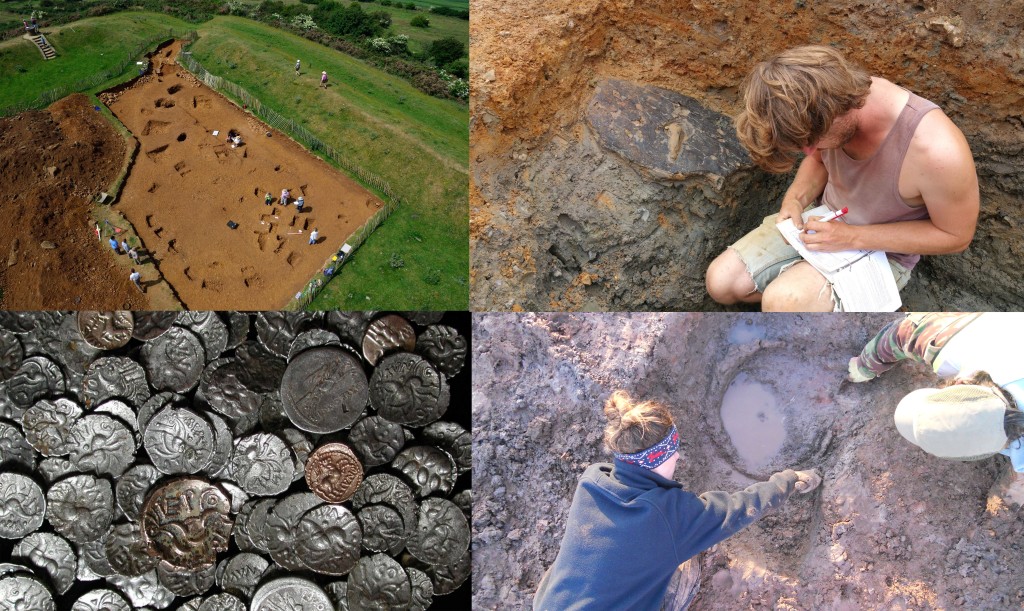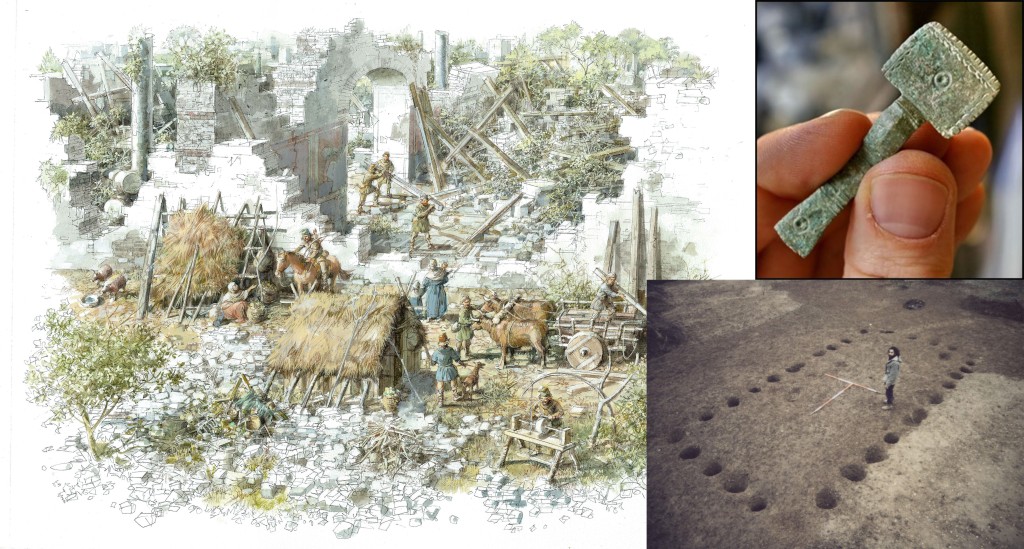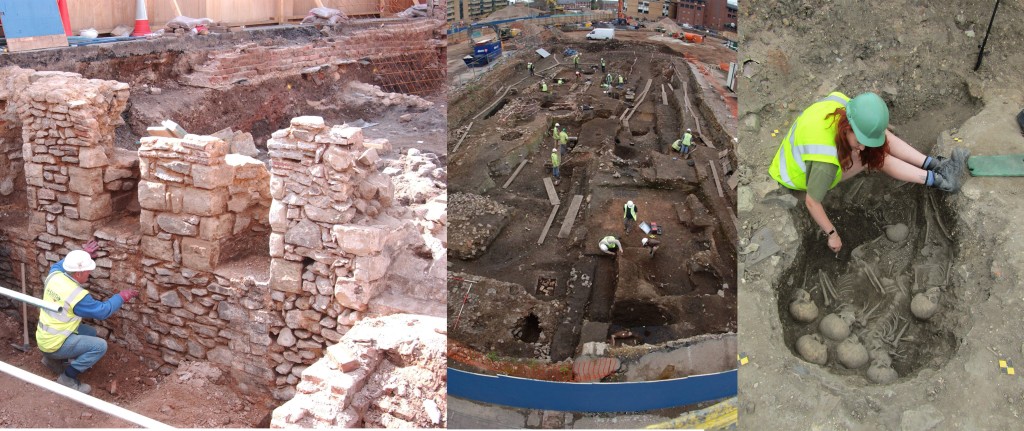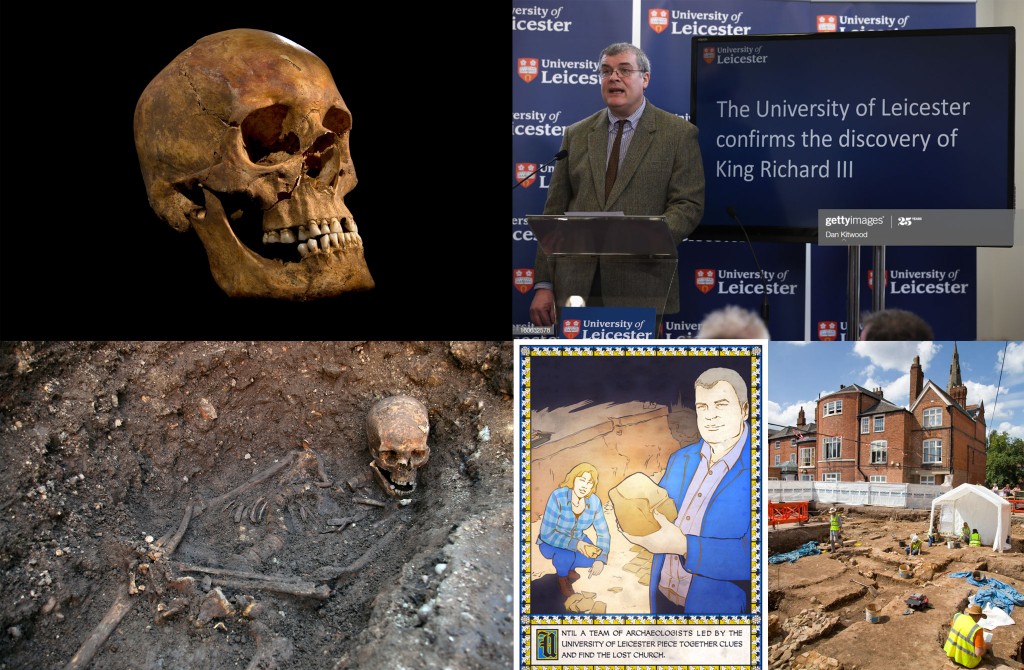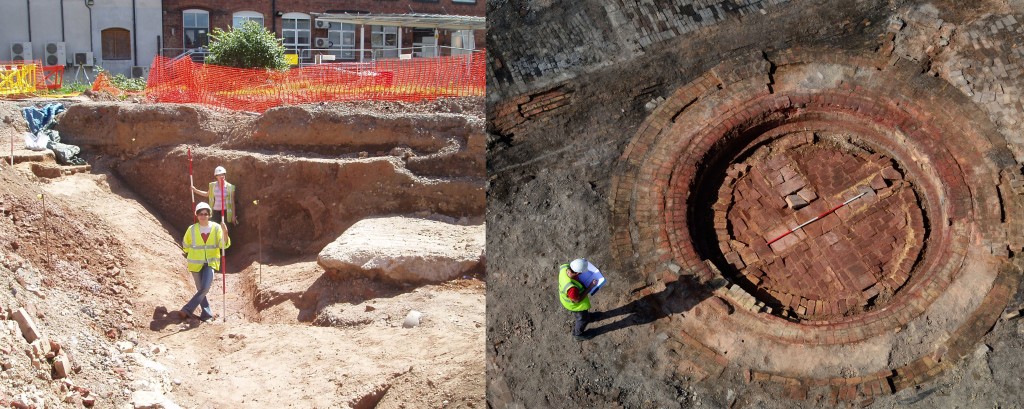ULAS have launched a new book celebrating their 25th Anniversary and presenting the best archaeological discoveries in Leicestershire and Rutland from the last quarter century.
Back in 1995 when the council-owned archaeology unit (‘LAU’) was closed, the head of the School of Archaeology at the time (Prof. Graeme Barker) was keen to expand the School to include a commercial unit at the University of Leicester. Combining with Paul Beavitt and Ron Hodgson at the University, along with help from Alan McWhirr, meetings in the snug at the Cradock Arms witnessed former LAU employees Patrick Clay and Richard Buckley putting together a business plan that would underpin the formation of University of Leicester Archaeological Services in July 1995. Since then ULAS have completed thousands of archaeological projects, often in advance of housing, commercial infrastructures, new roads and pipelines, and quarries within the East Midlands and beyond. ULAS currently employ around 50 archaeologists, each with a wealth of local knowledge and specialist expertise. Whilst ULAS work across the East Midlands, the majority of their projects are in Leicestershire and Rutland, hence the focus of the new book on the most exciting discoveries within these two counties.
“One of the strengths of ULAS is being part of the School of Archaeology and Ancient History at the University of Leicester, fostering close connections with its research and teaching. Our work is supported by academics, and we contribute towards training students to professional standards. We have strong links to the wider community, participating in many ‘outreach’ events and regularly giving talks to local societies, schools, and other groups”.
Vicki Score, Director of ULAS
Vicki Score, Director of ULAS
“The School is extremely proud to have worked in partnership with ULAS for the last 25 years. As they have grown in stature as one of the UK’s major units, so the School has also grown along with them. ULAS’ commitment to our teaching programs and outreach activities improves and enhances the student experience and provides important links between the University and the wider community. Having the unit staff work alongside undergraduates and postgraduates provides important opportunities for students to gain professional skills, within CIfA accredited programmes, ahead of their future employment beyond the University of Leicester – or indeed within the University, as many graduates are now employees! All of us in the School recognise the value of having a commercial enterprise like ULAS working in partnership with the academic community in the School. We all look forward to future collaborations as researchers, educators, and sometimes, as with the wider public, as fans of the archaeological discoveries.”
Dr Huw Barton, Head of the School of Archaeology and Ancient History, University of Leicester
Dr Huw Barton, Head of the School of Archaeology and Ancient History, University of Leicester
Discoveries span across time, with the earliest from a quarry just north of Leicester at Brooksby, where – in 2006 – a Palaeolithic river, bones from a straight-tusked elephant, along with hunter-gather artefacts from 500,000 years ago were uncovered. Elsewhere, in the east of the county at Glaston, evidence for a Palaeolithic hunting ground (both human and hyaena) were discovered in 2000, along with further Palaeolithic hunting grounds at Bradgate Park in 2014 and Launde in 1996. Sites from the Mesolithic period (11,000-6,000 years ago) are usually very rare in this region, the exception is in 2008 at Asfordby where thousands of worked lithics were discovered close to hearths, radiocarbon dated to around 8,000 cal. BC.
The Neolithic (4000-2500 BC) sees the beginnings of agriculture in Britain, and the emergence of more permanent settlements. These are rarely seen in our region, yet remarkably two sites from the same village – Rothley in 2005 and 2010 – revealed structures, worked lithics, and an remarkable stone plaque with decorated lines and shapes that may represent a face. The period is also characterised by large ceremonial and burial monuments. In 1998 a huge circular monument – a causewayed enclosure, formed by two parallel ditches – the size of three football pitches was discovered at Husbands Bosworth, along with a smaller henge and burial.
The transition from the Neolithic to Bronze Age (2500-800 BC) was gradual and was characterised by expansion into areas of previously unexploited land, from 1996-99 ULAS excavated at Watermead Country Park, exploring a river-edge site used seasonally by transient people for a variety of activities. The Bronze Age also saw the construction of numerous ceremonial and burial monuments, ULAS investigated two Bronze Age round barrows at nearby Cossington from 1999-2001, and a monumental complex consisting of opposed pairs of large ring ditches and D-shaped enclosures at Eye Kettleby in 1996-97.
At the time ULAS was founded, this region was viewed as rather a cultural backwater in the Iron Age (800 BC-AD 43), but the huge amount of information about the Iron Age landscape of Leicestershire gathered by ULAS over the past 25 years has revealed a rich variety of settlements and important ritual centres, and demonstrated trading links with other areas.
In 2013-14 a large agglomerated Iron Age settlement showed evidence for several large cauldrons and even a sword. Hillforts are one of the most recognisable features of the Iron Age landscape, dominating their surroundings. In 2010 a five-year programme incorporated the School of Archaeology & Ancient History’s field school for training undergraduates at Burrough Hill. This is one of the best preserved hillfort in the East Midlands, and the project revealed numerous small enclosures and other boundaries and a series of roundhouses nestled in the lee of the ramparts.
Another truly outstanding discovery came in a field near Hallaton in 2000 where a local metal detectorist found over 200 mainly Iron Age silver coins. From 2001–3 ULAS and the local fieldwork group undertook an excavation revealing a sacred place. The spectacular finds included a superb Roman cavalry helmet along with thousands of silver and gold coins, transforming our understanding of pre-Roman societies in the East Midlands and throw new light on the Roman conquest.
In 2015 an excavation close to Fosse Park on the outskirts of Leicester revealed a unique 2,300-year-old bark shield, the only known example in Europe! The shield was made from a thin layer of bark, into which narrow split laths had been driven. The shield was edged with a rim of split hazel, and a handle of willow roundwood was attached with withy ties. The outside of the shield had been decorated with fine lines cut at right angles into the surface forming squares and rectangles. Red ochre paint had been used to infill some of the shapes, forming a chequerboard design. Shields are rare in British prehistory and one constructed from bark is unprecedented, making this finely crafted and carefully decorated artefact completely unique in Europe.
In the last quarter century, our understanding of Roman Leicester (AD 43-410) has been transformed, with a variety of public and private buildings, colourful mosaics, and burials uncovered. The most extensive phases of work, between 2003–9, saw major excavations in advance of building the Highcross Leicester retail quarter, as well as at De Montfort University and the Leicester Square development on Sanvey Gate. A second wave of redevelopment from 2016–19 led to excavations to the west of Highcross Street, and close to the River Soar in the Bath Lane and Waterside area. Over 15% of the historic walled area of Roman and medieval Leicester has now been investigated. The result is that Leicester is one of the most intensively excavated cities in the UK, greatly enhancing our in-depth understanding of Leicester’s ancient past.
Until recently the nature of settlement during the early Anglo-Saxon period (AD 410-650) has been poorly understood. Thanks to the large-scale excavations in the 2000s, we can now see that life within Leicester continued, but in a much-transformed way. We also now know more about nearby settlements, ULAS’ first big project in 1996 – an Anglo-Saxon Settlement at Eye Kettleby discovered over 50 structures along with pottery, brooches, and tools – it is still the largest Saxon settlement excavated in the county.
Urban excavations have shed light on many aspects of medieval Leicester, with buildings, a brewery, burials and churches, and even an abbey investigated. In 2003 archaeological work ahead of the new BBC Radio Leicester building revealed extensive and well-preserved medieval domestic and industrial structures of the thirteenth to fifteenth centuries. As well as a number typical narrow urban tenement (building) plots, the excavations uncovered a stone undercroft built between 1150–1250, the first example from Leicester of a type of structure long recognised in other medieval towns. Further along Highcross Street, in 2005, an excavation revealed Saxo-Norman, medieval and post-medieval buildings set out in long narrow properties. The earliest structures were timber buildings dating to the later 9th or 10th century, the first Saxo-Norman buildings found in Leicester. By the 12th century they had been replaced with more substantial timber-framed buildings that rested on stone footings. By the 14th century, the yard behind one building contained stone ovens and kilns associated with brewing.
Three medieval parish churches – St Peter, St Clement and St Michael – existed until the 16th century, but after they were demolished their exact locations went unrecorded and were eventually forgotten. During excavations in the mid-2000s and again in 2018–19, the three ‘lost’ parish churches were rediscovered, along with their accompanying cemeteries. Over 2,000 skeletons were carefully exhumed from the three churchyards, combining to make one of the largest investigations of a medieval town’s population in the East Midlands, and providing a rare opportunity to examine the health and lifestyle of many of the inhabitants of medieval Leicester.
Since the late 1990s ULAS has been closely involved in the running of various undergraduate fieldwork training excavations. From 2000–09 the site of Leicester Abbey was investigated as part of a School of Archaeology and Ancient History field school for students. Whilst in 2003, the inhabitants of Great Easton, in south-east Leicestershire, together with ULAS and Channel 4’s Time Team, undertook a test-pit investigation across the gardens in the village to try to establish the origins of the village and to chart its subsequent development. The project complemented longer-term ‘community archaeology’ programmes, for which ULAS has been involved in throughout the last 25 years, notably most recently in 2016-18 at Oakham Castle. From 2015–19 a student training and research excavation was undertaken in the popular recreational park of Bradgate Park, a park best known as the location of an unfortified brick-built aristocratic house, the birthplace and childhood home of Lady Jane Grey, (uncrowned) Queen of England for 9 days in 1553. The central aim of the project was to enhance community involvement in the understanding and presentation of this important regional monument for the benefit of the wider public.
One of the most memorable discoveries of the last 25 years of ULAS occurred in August 2012, when an archaeological project at Grey Friars Street in Leicester rediscovered the lost grave of Richard III, the last English king to die in battle. The grave had lain lost but undisturbed beneath a city centre car park (previously a garden) for more than 500 years until a search, initiated by Philippa Langley and undertaken by the University of Leicester (in partnership with the Richard III Society and Leicester City Council), managed to relocate the remains of one of England’s more notorious medieval monarchs. It was a discovery earned in large part though the detailed knowledge and long-term commitment with development work in the city of Leicester. The award of the Queen’s Anniversary Prize in 2013, held jointly with the University of Leicester, recognised ULAS’ long record of exceptional research, commercial archaeology and public engagement in history and heritage of which the discovery of Richard III was an important highlight.
Over the past 25 years, ULAS excavations around the Newarke – today the campus of De Montfort University – along Mill Lane, Bonners Lane, Grange Lane, Oxford Street and York Road, have revealed extensive evidence for the civil war defences (constructed during the First English Civil War, 1642–46). Leicester was besieged and ‘miserably plundered’ by the Royalists under Charles I and his nephew Prince Rupert on 28–31 May 1645, before Parliamentarian forces under Sir Thomas Fairfax recaptured the town a fortnight later on June 16. These defences consisted of massive ditches and earth ramparts and included a horn work described as the ‘Southgate Sentry’, protecting the approach to the town along Oxford Street. Close to the Newarke Gateway, a 10m-wide earth rampart was fronted by a 6m-wide ditch that was over 2m deep. Here for the first time, clear evidence was found for the demolition of buildings before the ditch was dug.
More recent archaeology from the 19th and 20th centuries has been investigated over the years. Notable sites include a former pottery factory at Coleorton in north-west Leicestershire in 2012, where well-preserved brick kilns provided significant new information on the Coleorton pottery industry. Canal locks at Foxton have the largest flight of staircase locks on the English canal system, and ‘Inclined Plane’ on the Leicester line of the Grand Union Canal. ULAS undertook work between 2006 and 2008, this resulted in making this notable piece of Victorian technology much more understandable. ULAS has also been involved in several building recording projects associated with civil defence. During the Second World War, in late 1939 and 1940 a number of Leicester schools constructed shelters for their pupils which could also be used by civilians during night-time bombing raids, the surveys revealed many fascinating details, including some Graffiti on the walls that included aircraft, cartoons, and even a Hitler caricature!
The new book describes these projects and more, along with many photographs and reconstruction illustrations. Entitled ‘Secrets from the Soil. University of Leicester Archaeological Services: A Quarter Century of discoveries from Palaeolithic to Modern Times’ is compiled by Dr Gavin Speed (Project Manager at ULAS) who says:
“This book acts as a ‘greatest hits’ of ULAS’ first 25 years. The outstanding discoveries showcased in this 25-year anniversary book, would not have been possible without the contribution of the many organisations who funded these projects over the years. The majority of the text was written by, or based on, the work of current and former ULAS staff: Steve Baker, Matthew Beamish, Richard Buckley, Jen Browning, Lynden Cooper, Nick Cooper, Patrick Clay, Jon Coward, Neil Finn, Anthony Gnanaratnam, James Harvey, Tim Higgins, Leon Hunt, Andy Hyam, Wayne Jarvis, Steve Jones, Roger Kipling, Mathew Morris, John Thomas, Susan Ripper, Vicki Score, and Gavin Speed. Thanks also to assistance from John Thomas and Pamela Lowther. Thanks are also due to the amazing people who work and have worked for ULAS over the last quarter century, too numerous to mention here, who often toiled through hard weather and difficult working conditions to reveal some of the Secrets from the Soil of Leicestershire and Rutland”.
The book is priced at £9.95 and available to buy at Shop@le: https://shop.le.ac.uk/product-catalogue/books-and-gifts/leicester-archaeology-monographs/secrets-from-the-soil
Source: ULAS

